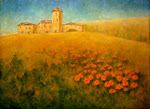Certainly, when we think Renaissance we think da Vinci, Michelangelo, Donatello, etc. But those Byzantium rebels, Cimabue and his student, Giotto, are seldom ascribed their proper respect as trailblazers for the Renaissance. What was so special about Cimabue and Giotto?
Cimabue broke with the rigidity of Byzantine Art and expressed, in realistic detail, emotion in his subjects, as opposed to the Church’s symbolic terms. This doesn’t sound like any big deal, but in the days when the Church had a strangle hold on every aspect of the do’s and don’ts of everyday life, believe me, it was one giant step for future artists to follow.
Giotto’s paintings continued to explore Christian themes, but they did so figured with people who walked and talked equally with Christ. This was another big leap toward the Renaissance, when artists began to celebrate “human” feats and accomplishments, not just those of an invisible God.
So let’s tip our hats to Cimabue and Giotto for stepping on more than a few Catholic toes and leading the way to the Renaissance, which is considered the greatest art movement in the history of the world.
The Basilica di San Francesco in Assisi includes frescoes by these two pre-Renaissance giants. Two of the most celebrated frescos are: St Francis Preaching to the Birds, by Giotto, and Virgin and Child, by Cimabue.
Welcome
Many artists dream about painting in Italy. Now, as retiring baby-boomers are increasingly taking up “brush and pallet knife,” more than ever, painting in Italy is the “thing.” Every day, a new “Artist’s” tour of Italy crops up in travel sections of the newspaper and on the Internet. But there still remains a majority of artists who prefer to “go it alone.” They are independent in their artistic styles, and prefer to be independent regarding their travels in Italy . This blog intends to target these free spirited artists who still need guidance to the best places to paint, especially those idyllic gems that are little known and less traveled. Certainly, independent travelers who are not artists will also benefit from this blog.
With a few exceptions, this blog is not a guide to restaurants, lodging, rental cars, or shopping, (except for art supplies.)
Sprinkled among the posts are: my paintings, and a few Italian proverbs and poems written by notable Italian authors for whom I work as a translator.
Please visit my website to view my original art:
http://www.pamelaallegretto-franz.com/
Giclee prints of my paintings, ranging from greeting size to poster size, can be purchased at:
http://pamela-allegretto.fineartamerica.com/
With a few exceptions, this blog is not a guide to restaurants, lodging, rental cars, or shopping, (except for art supplies.)
Sprinkled among the posts are: my paintings, and a few Italian proverbs and poems written by notable Italian authors for whom I work as a translator.
Please visit my website to view my original art:
http://www.pamelaallegretto-franz.com/
Giclee prints of my paintings, ranging from greeting size to poster size, can be purchased at:
http://pamela-allegretto.fineartamerica.com/
Wednesday, March 25, 2009
Subscribe to:
Post Comments (Atom)





No comments:
Post a Comment
Thank you for your comment. Grazie per i complimenti.
Note: Only a member of this blog may post a comment.